Videoconferencing
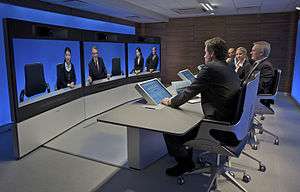
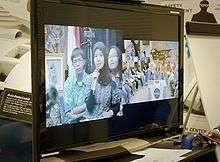
Videoconferencing (VC) is the conduct of a videoconference (also known as a video conference or videoteleconference) by a set of telecommunication technologies which allow two or more locations to communicate by simultaneous two-way video and audio transmissions. It has also been called 'visual collaboration' and is a type of groupware.
Videoconferencing differs from videophone calls in that it's designed to serve a conference or multiple locations rather than individuals.[1] It is an intermediate form of videotelephony, first used commercially in Germany during the late-1930s and later in the United States during the early 1970s as part of AT&T's development of Picturephone technology.
With the introduction of relatively low cost, high capacity broadband telecommunication services in the late 1990s, coupled with powerful computing processors and video compression techniques, videoconferencing has made significant inroads in business, education, medicine and media.
History

Videoconferencing uses audio and video telecommunications to bring people at different sites together. This can be as simple as a conversation between people in private offices (point-to-point) or involve several (multipoint) sites in large rooms at multiple locations. Besides the audio and visual transmission of meeting activities, allied videoconferencing technologies can be used to share documents and display information on whiteboards.
Simple analog videophone communication could be established as early as the invention of the television. Such an antecedent usually consisted of two closed-circuit television systems connected via coax cable or radio. An example of that was the German Reich Postzentralamt (post office) video telephone network serving Berlin and several German cities via coaxial cables between 1936 and 1940.[2][3]
During the first manned space flights, NASA used two radio-frequency (UHF or VHF) video links, one in each direction. TV channels routinely use this type of videotelephony when reporting from distant locations. The news media were to become regular users of mobile links to satellites using specially equipped trucks, and much later via special satellite videophones in a briefcase.
This technique was very expensive, though, and could not be used for applications such as telemedicine, distance education, and business meetings. Attempts at using normal telephony networks to transmit slow-scan video, such as the first systems developed by AT&T Corporation, first researched in the 1950s, failed mostly due to the poor picture quality and the lack of efficient video compression techniques. The greater 1 MHz bandwidth and 6 Mbit/s bit rate of the Picturephone in the 1970s also did not achieve commercial success, mostly due to its high cost, but also due to a lack of network effect —with only a few hundred Picturephones in the world, users had extremely few contacts they could actually call to, and interoperability with other videophone systems would not exist for decades.
It was only in the 1980s that digital telephony transmission networks became possible, such as with ISDN networks, assuring a minimum bit rate (usually 128 kilobits/s) for compressed video and audio transmission. During this time, there was also research into other forms of digital video and audio communication. Many of these technologies, such as the Media space, are not as widely used today as videoconferencing but were still an important area of research.[4][5] The first dedicated systems started to appear in the market as ISDN networks were expanding throughout the world. One of the first commercial videoconferencing systems sold to companies came from PictureTel Corp., which had an Initial Public Offering in November, 1984.
In 1984 Concept Communication in the United States replaced the then-100 pound, US$100,000 computers necessary for teleconferencing, with a $12,000 circuit board that doubled the video frame rate from 15 up to 30 frames per second, and which reduced the equipment to the size of a circuit board fitting into standard personal computers.[6] The company also secured a patent for a codec for full-motion videoconferencing, first demonstrated at AT&T Bell Labs in 1986.[6][7]
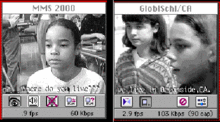
Videoconferencing systems throughout the 1990s rapidly evolved from very expensive proprietary equipment, software and network requirements to a standards-based technology readily available to the general public at a reasonable cost.
Finally, in the 1990s, Internet Protocol-based videoconferencing became possible, and more efficient video compression technologies were developed, permitting desktop, or personal computer (PC)-based videoconferencing. In 1992 CU-SeeMe was developed at Cornell by Tim Dorcey et al. In 1995 the first public videoconference between North America and Africa took place, linking a technofair in San Francisco with a techno-rave and cyberdeli in Cape Town. At the Winter Olympics opening ceremony in Nagano, Japan, Seiji Ozawa conducted the Ode to Joy from Beethoven's Ninth Symphony simultaneously across five continents in near-real time.
While videoconferencing technology was initially used primarily within internal corporate communication networks, one of the first community service usages of the technology started in 1992 through a unique partnership with PictureTel and IBM Corporations which at the time were promoting a jointly developed desktop based videoconferencing product known as the PCS/1. Over the next 15 years, Project DIANE (Diversified Information and Assistance Network) grew to utilize a variety of videoconferencing platforms to create a multi-state cooperative public service and distance education network consisting of several hundred schools, neighborhood centers, libraries, science museums, zoos and parks, public assistance centers, and other community oriented organizations.
In the 2000s, videotelephony was popularized via free Internet services such as Skype and iChat, web plugins and on-line telecommunication programs that promoted low cost, albeit lower-quality, videoconferencing to virtually every location with an Internet connection.
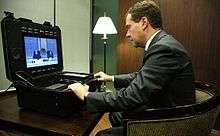
In May 2005, the first high definition video conferencing systems, produced by LifeSize Communications, were displayed at the Interop trade show in Las Vegas, Nevada, able to provide video at 30 frames per second with a 1280 by 720 display resolution.[8][9] Polycom introduced its first high definition video conferencing system to the market in 2006. As of the 2010s, high definition resolution for videoconferencing became a popular feature, with most major suppliers in the videoconferencing market offering it.
Technological developments by videoconferencing developers in the 2010s have extended the capabilities of video conferencing systems beyond the boardroom for use with hand-held mobile devices that combine the use of video, audio and on-screen drawing capabilities broadcasting in real-time over secure networks, independent of location. Mobile collaboration systems now allow multiple people in previously unreachable locations, such as workers on an off-shore oil rig, the ability to view and discuss issues with colleagues thousands of miles away. Traditional videoconferencing system manufacturers have begun providing mobile applications as well, such as those that allow for live and still image streaming.[10]
Technology
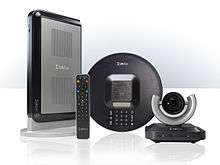

The core technology used in a videoconferencing system is digital compression of audio and video streams in real time. The hardware or software that performs compression is called a codec (coder/decoder). Compression rates of up to 1:500 can be achieved. The resulting digital stream of 1s and 0s is subdivided into labeled packets, which are then transmitted through a digital network of some kind (usually ISDN or IP). The use of audio modems in the transmission line allow for the use of POTS, or the Plain Old Telephone System, in some low-speed applications, such as videotelephony, because they convert the digital pulses to/from analog waves in the audio spectrum range.
The other components required for a videoconferencing system include:
- Video input: (PTZ / 360° / Fisheye) video camera or webcam
- Video output: computer monitor, television or projector
- Audio input: microphones, CD/DVD player, cassette player, or any other source of PreAmp audio outlet.
- Audio output: usually loudspeakers associated with the display device or telephone
- Data transfer: analog or digital telephone network, LAN or Internet
- Computer: a data processing unit that ties together the other components, does the compressing and decompressing, and initiates and maintains the data linkage via the network.
There are basically two kinds of videoconferencing systems:
- Dedicated systems have all required components packaged into a single piece of equipment, usually a console with a high quality remote controlled video camera. These cameras can be controlled at a distance to pan left and right, tilt up and down, and zoom. They became known as PTZ cameras. The console contains all electrical interfaces, the control computer, and the software or hardware-based codec. Omnidirectional microphones are connected to the console, as well as a TV monitor with loudspeakers and/or a video projector. There are several types of dedicated videoconferencing devices:
- Large group videoconferencing are non-portable, large, more expensive devices used for large rooms and auditoriums.
- Small group videoconferencing are non-portable or portable, smaller, less expensive devices used for small meeting rooms.
- Individual videoconferencing are usually portable devices, meant for single users, have fixed cameras, microphones and loudspeakers integrated into the console.
- Desktop systems are add-ons (hardware boards or software codec) to normal PCs and laptops, transforming them into videoconferencing devices. A range of different cameras and microphones can be used with the codec, which contains the necessary codec and transmission interfaces. Most of the desktops systems work with the H.323 standard. Videoconferences carried out via dispersed PCs are also known as e-meetings. These can also be nonstandard, Microsoft Lync, Skype for Business, Google Hangouts, or Yahoo Messenger or standards based, Cisco Jabber.
- WebRTC Platforms are video conferencing solutions that are not resident by using a software application but is available through the standard web browser. Solutions such as Adobe Connect and Cisco WebEX can be accessed by going to a URL sent by the meeting organizer and various degrees of security can be attached to the virtual "room". Often the user will be required to download a piece of software, called an "Add In" to enable the browser to access the local camera, microphone and establish a connection to the meeting. WebRTC technology doesn't require any software or Add On installation, instead a WebRTC compliant internet browser itself acts as a client to facilitate 1-to-1 and 1-to-many videoconferencing calls. Several enhanced flavours of WebRTC technology are being provided by Third Party vendors.
Conferencing layers
The components within a Conferencing System can be divided up into several different layers: User Interface, Conference Control, Control or Signal Plane, and Media Plane.
Videoconferencing User Interfaces (VUI) can be either graphical or voice responsive. Many in the industry have encountered both types of interfaces, and normally graphical interfaces are encountered on a computer. User interfaces for conferencing have a number of different uses; they can be used for scheduling, setup, and making a videocall. Through the user interface the administrator is able to control the other three layers of the system.
Conference Control performs resource allocation, management and routing. This layer along with the User Interface creates meetings (scheduled or unscheduled) or adds and removes participants from a conference.
Control (Signaling) Plane contains the stacks that signal different endpoints to create a call and/or a conference. Signals can be, but aren’t limited to, H.323 and Session Initiation Protocol (SIP) Protocols. These signals control incoming and outgoing connections as well as session parameters.
The Media Plane controls the audio and video mixing and streaming. This layer manages Real-Time Transport Protocols, User Datagram Packets (UDP) and Real-Time Transport Control Protocol (RTCP). The RTP and UDP normally carry information such the payload type which is the type of codec, frame rate, video size and many others. RTCP on the other hand acts as a quality control Protocol for detecting errors during streaming.[11]
Multipoint videoconferencing
Simultaneous videoconferencing among three or more remote points is possible by means of a Multipoint Control Unit (MCU). This is a bridge that interconnects calls from several sources (in a similar way to the audio conference call). All parties call the MCU, or the MCU can also call the parties which are going to participate, in sequence. There are MCU bridges for IP and ISDN-based videoconferencing. There are MCUs which are pure software, and others which are a combination of hardware and software. An MCU is characterised according to the number of simultaneous calls it can handle, its ability to conduct transposing of data rates and protocols, and features such as Continuous Presence, in which multiple parties can be seen on-screen at once. MCUs can be stand-alone hardware devices, or they can be embedded into dedicated videoconferencing units.
The MCU consists of two logical components:
- A single multipoint controller (MC), and
- Multipoint Processors (MP), sometimes referred to as the mixer.
The MC controls the conferencing while it is active on the signaling plane, which is simply where the system manages conferencing creation, endpoint signaling and in-conferencing controls. This component negotiates parameters with every endpoint in the network and controls conferencing resources. While the MC controls resources and signaling negotiations, the MP operates on the media plane and receives media from each endpoint. The MP generates output streams from each endpoint and redirects the information to other endpoints in the conference.
Some systems are capable of multipoint conferencing with no MCU, stand-alone, embedded or otherwise. These use a standards-based H.323 technique known as "decentralized multipoint", where each station in a multipoint call exchanges video and audio directly with the other stations with no central "manager" or other bottleneck. The advantages of this technique are that the video and audio will generally be of higher quality because they don't have to be relayed through a central point. Also, users can make ad-hoc multipoint calls without any concern for the availability or control of an MCU. This added convenience and quality comes at the expense of some increased network bandwidth, because every station must transmit to every other station directly.[11]
Videoconferencing modes
Videoconferencing systems use several common operating modes:
- Voice-Activated Switch (VAS);
- Continuous Presence.
In VAS mode, the MCU switches which endpoint can be seen by the other endpoints by the levels of one's voice. If there are four people in a conference, the only one that will be seen in the conference is the site which is talking; the location with the loudest voice will be seen by the other participants.
Continuous Presence mode, displays multiple participants at the same time. The MP in this mode takes the streams from the different endpoints and puts them all together into a single video image. In this mode, the MCU normally sends the same type of images to all participants. Typically these types of images are called "layouts" and can vary depending on the number of participants in a conference.[11]
Echo cancellation
A fundamental feature of professional videoconferencing systems is Acoustic Echo Cancellation (AEC). Echo can be defined as the reflected source wave interference with new wave created by source. AEC is an algorithm which is able to detect when sounds or utterances reenter the audio input of the videoconferencing codec, which came from the audio output of the same system, after some time delay. If unchecked, this can lead to several problems including:
- the remote party hearing their own voice coming back at them (usually significantly delayed)
- strong reverberation, which makes the voice channel useless, and
- howling created by feedback.
Echo cancellation is a processor-intensive task that usually works over a narrow range of sound delays.
Cloud-based video conferencing
Cloud-based video conferencing can be used without the hardware generally required by other video conferencing systems, and can be designed for use by SMEs,[12] or larger international companies like Facebook.[13][14] Cloud-based systems can handle either 2D or 3D video broadcasting.[15] Cloud-based systems can also implement mobile calls, VOIP, and other forms of video calling. They can also come with a video recording function to archive past meetings.[16]
Technical and other issues
Computer security experts have shown that poorly configured or inadequately supervised videoconferencing system can permit an easy 'virtual' entry by computer hackers and criminals into company premises and corporate boardrooms, via their own videoconferencing systems.[17] Some observers argue that three outstanding issues have prevented videoconferencing from becoming a standard form of communication, despite the ubiquity of videoconferencing-capable systems.[18] These issues are:
- Eye contact: Eye contact plays a large role in conversational turn-taking, perceived attention and intent, and other aspects of group communication.[19] While traditional telephone conversations give no eye contact cues, many videoconferencing systems are arguably worse in that they provide an incorrect impression that the remote interlocutor is avoiding eye contact. Some telepresence systems have cameras located in the screens that reduce the amount of parallax observed by the users. This issue is also being addressed through research that generates a synthetic image with eye contact using stereo reconstruction.[20]
Telcordia Technologies, formerly Bell Communications Research, owns a patent for eye-to-eye videoconferencing using rear projection screens with the video camera behind it, evolved from a 1960s U.S. military system that provided videoconferencing services between the White House and various other government and military facilities. This technique eliminates the need for special cameras or image processing.[21] - Appearance consciousness: A second psychological problem with videoconferencing is being on camera, with the video stream possibly even being recorded. The burden of presenting an acceptable on-screen appearance is not present in audio-only communication. Early studies by Alphonse Chapanis found that the addition of video actually impaired communication, possibly because of the consciousness of being on camera.[22]
- Signal latency: The information transport of digital signals in many steps need time. In a telecommunicated conversation, an increased latency (time lag) larger than about 150–300 ms becomes noticeable and is soon observed as unnatural and distracting. Therefore, next to a stable large bandwidth, a small total round-trip time is another major technical requirement for the communication channel for interactive videoconferencing.[23]
The issue of eye-contact may be solved with advancing technology, and presumably the issue of appearance consciousness will fade as people become accustomed to videoconferencing.
Standards
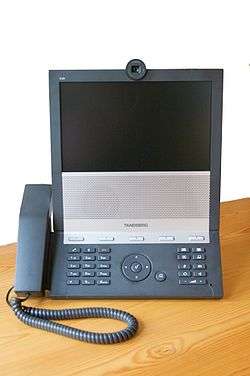
The International Telecommunications Union (ITU) (formerly: Consultative Committee on International Telegraphy and Telephony (CCITT)) has three umbrellas of standards for videoconferencing:
- ITU H.320 is known as the standard for public switched telephone networks (PSTN) or videoconferencing over integrated services digital networks. While still prevalent in Europe, ISDN was never widely adopted in the United States and Canada.
- ITU H.264 Scalable Video Coding (SVC) is a compression standard that enables videoconferencing systems to achieve highly error resilient Internet Protocol (IP) video transmissions over the public Internet without quality-of-service enhanced lines.[24] This standard has enabled wide scale deployment of high definition desktop videoconferencing and made possible new architectures,[25] which reduces latency between the transmitting sources and receivers, resulting in more fluid communication without pauses. In addition, an attractive factor for IP videoconferencing is that it is easier to set up for use along with web conferencing and data collaboration. These combined technologies enable users to have a richer multimedia environment for live meetings, collaboration and presentations.
- ITU V.80: videoconferencing is generally compatibilized with H.324 standard point-to-point videotelephony over regular plain old telephone service (POTS) phone lines.
The Unified Communications Interoperability Forum (UCIF), a non-profit alliance between communications vendors, launched in May 2010. The organization's vision is to maximize the interoperability of UC based on existing standards. Founding members of UCIF include HP, Microsoft, Polycom, Logitech/LifeSize Communications and Juniper Networks.[26][27]
Social and institutional impact
Impact on the general public
High speed Internet connectivity has become more widely available at a reasonable cost and the cost of video capture and display technology has decreased. Consequently, personal videoconferencing systems based on a webcam, personal computer system, software compression and broadband Internet connectivity have become affordable to the general public. Also, the hardware used for this technology has continued to improve in quality, and prices have dropped dramatically. The availability of freeware (often as part of chat programs) has made software based videoconferencing accessible to many.
For over a century, futurists have envisioned a future where telephone conversations will take place as actual face-to-face encounters with video as well as audio. Sometimes it is simply not possible or practical to have face-to-face meetings with two or more people. Sometimes a telephone conversation or conference call is adequate. Other times, e-mail exchanges are adequate. However, videoconferencing adds another possible alternative, and can be considered when:
- a live conversation is needed;
- non-verbal (visual) information is an important component of the conversation;
- the parties of the conversation can't physically come to the same location; or
- the expense or time of travel is a consideration.
Deaf, hard-of-hearing and mute individuals have a particular interest in the development of affordable high-quality videoconferencing as a means of communicating with each other in sign language. Unlike Video Relay Service, which is intended to support communication between a caller using sign language and another party using spoken language, videoconferencing can be used directly between two deaf signers.
Mass adoption and use of videoconferencing is still relatively low, with the following often claimed as causes:
- Complexity of systems. Most users are not technical and want a simple interface. In hardware systems an unplugged cord or a flat battery in a remote control is seen as failure, contributing to perceived unreliability which drives users back to traditional meetings. Successful systems are backed by support teams who can pro-actively support and provide fast assistance when required.
- Perceived lack of interoperability: not all systems can readily interconnect, for example ISDN and IP systems require a gateway. Popular software solutions cannot easily connect to hardware systems. Some systems use different standards, features and qualities which can require additional configuration when connecting to dissimilar systems.
- Bandwidth and quality of service: In some countries it is difficult or expensive to get a high quality connection that is fast enough for good-quality video conferencing. Technologies such as ADSL have limited upload speeds and cannot upload and download simultaneously at full speed. As Internet speeds increase higher quality and high definition video conferencing will become more readily available.
- Expense of commercial systems: well-designed telepresence systems require specially designed rooms which can cost hundreds of thousands of dollars to fit out their rooms with codecs, integration equipment (such as Multipoint Control Units), high fidelity sound systems and furniture. Monthly charges may also be required for bridging services and high capacity broadband service.
- Self-consciousness about being on camera: especially for new users or older generations who may prefer less fidelity in their communications.
- Lack of direct eye contact, an issue being circumvented in some higher end systems.
These are some of the reasons many systems are often used for internal corporate use only, as they are less likely to result in lost sales. One alternative to companies lacking dedicated facilities is the rental of videoconferencing-equipped meeting rooms in cities around the world. Clients can book rooms and turn up for the meeting, with all technical aspects being prearranged and support being readily available if needed.
Impact on government and law
In the United States, videoconferencing has allowed testimony to be used for an individual who is unable or prefers not to attend the physical legal settings, or would be subjected to severe psychological stress in doing so, however there is a controversy on the use of testimony by foreign or unavailable witnesses via video transmission, regarding the violation of the Confrontation Clause of the Sixth Amendment of the U.S. Constitution.[28]
In a military investigation in State of North Carolina, Afghan witnesses have testified via videoconferencing.
In Hall County, Georgia, videoconferencing systems are used for initial court appearances. The systems link jails with court rooms, reducing the expenses and security risks of transporting prisoners to the courtroom.[29]
The U.S. Social Security Administration (SSA), which oversees the world's largest administrative judicial system under its Office of Disability Adjudication and Review (ODAR),[30] has made extensive use of videoconferencing to conduct hearings at remote locations.[31] In Fiscal Year (FY) 2009, the U.S. Social Security Administration (SSA) conducted 86,320 videoconferenced hearings, a 55% increase over FY 2008.[32] In August 2010, the SSA opened its fifth and largest videoconferencing-only National Hearing Center (NHC), in St. Louis, Missouri. This continues the SSA's effort to use video hearings as a means to clear its substantial hearing backlog. Since 2007, the SSA has also established NHCs in Albuquerque, New Mexico, Baltimore, Maryland, Falls Church, Virginia, and Chicago, Illinois.[30]
Impact on education
Videoconferencing provides students with the opportunity to learn by participating in two-way communication forums. Furthermore, teachers and lecturers worldwide can be brought to remote or otherwise isolated educational facilities. Students from diverse communities and backgrounds can come together to learn about one another, although language barriers will continue to persist. Such students are able to explore, communicate, analyze and share information and ideas with one another. Through videoconferencing, students can visit other parts of the world to speak with their peers, and visit museums and educational facilities. Such virtual field trips can provide enriched learning opportunities to students, especially those in geographically isolated locations, and to the economically disadvantaged. Small schools can use these technologies to pool resources and provide courses, such as in foreign languages, which could not otherwise be offered.
A few examples of benefits that videoconferencing can provide in campus environments include:
- faculty members keeping in touch with classes while attending conferences;
- guest lecturers brought in classes from other institutions;[33]
- researchers collaborating with colleagues at other institutions on a regular basis without loss of time due to travel;
- schools with multiple campuses collaborating and sharing professors;[34]
- schools from two separate nations engaging in cross-cultural exchanges;[35]
- faculty members participating in thesis defenses at other institutions;
- administrators on tight schedules collaborating on budget preparation from different parts of campus;
- faculty committee auditioning scholarship candidates;
- researchers answering questions about grant proposals from agencies or review committees;
- student interviews with an employers in other cities, and
- teleseminars.
Impact on medicine and health
Videoconferencing is a highly useful technology for real-time telemedicine and telenursing applications, such as diagnosis, consulting, transmission of medical images, etc... With videoconferencing, patients may contact nurses and physicians in emergency or routine situations; physicians and other paramedical professionals can discuss cases across large distances. Rural areas can use this technology for diagnostic purposes, thus saving lives and making more efficient use of health care money. For example, a rural medical center in Ohio, United States, used videoconferencing to successfully cut the number of transfers of sick infants to a hospital 70 miles (110 km) away. This had previously cost nearly $10,000 per transfer.[36]
Special peripherals such as microscopes fitted with digital cameras, videoendoscopes, medical ultrasound imaging devices, otoscopes, etc., can be used in conjunction with videoconferencing equipment to transmit data about a patient. Recent developments in mobile collaboration on hand-held mobile devices have also extended video-conferencing capabilities to locations previously unreachable, such as a remote community, long-term care facility, or a patient's home.[37]
Impact on sign language communications
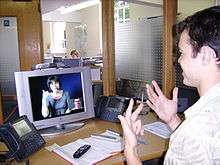
A video relay service (VRS), also known as a 'video interpreting service' (VIS), is a service that allows deaf, hard-of-hearing and speech-impaired (D-HOH-SI) individuals to communicate by videoconferencing (or similar technologies) with hearing people in real-time, via a sign language interpreter.
A similar video interpreting service called video remote interpreting (VRI) is conducted through a different organization often called a "Video Interpreting Service Provider" (VISP).[38] VRS is a newer form of telecommunication service to the D-HOH-SI community, which had, in the United States, started earlier in 1974 using a non-video technology called telecommunications relay service (TRS).
One of the first demonstrations of the ability for telecommunications to help sign language users communicate with each other occurred when AT&T's videophone (trademarked as the "Picturephone") was introduced to the public at the 1964 New York World's Fair –two deaf users were able to communicate freely with each other between the fair and another city.[39] Various universities and other organizations, including British Telecom's Martlesham facility, have also conducted extensive research on signing via videotelephony.[40][41][42] The use of sign language via videotelephony was hampered for many years due to the difficulty of its use over slow analogue copper phone lines,[41] coupled with the high cost of better quality ISDN (data) phone lines.[40] Those factors largely disappeared with the introduction of more efficient video codecs and the advent of lower cost high-speed ISDN data and IP (Internet) services in the 1990s.
VRS services have become well developed nationally in Sweden since 1997[43] and also in the United States since the first decade of the 2000s. With the exception of Sweden, VRS has been provided in Europe for only a few years since the mid-2000s, and as of 2010 has not been made available in many European Union countries,[44] with most European countries still lacking the legislation or the financing for large-scale VRS services, and to provide the necessary telecommunication equipment to deaf users. Germany and the Nordic countries are among the other leaders in Europe, while the United States is another world leader in the provisioning of VRS services.
Impact on business
Videoconferencing can enable individuals in distant locations to participate in meetings on short notice, with time and money savings. Technology such as VoIP can be used in conjunction with desktop videoconferencing to enable low-cost face-to-face business meetings without leaving the desk, especially for businesses with widespread offices. The technology is also used for telecommuting, in which employees work from home. One research report based on a sampling of 1,800 corporate employees showed that, as of June 2010, 54% of the respondents with access to video conferencing used it "all of the time" or "frequently".[45][46]
Intel Corporation have used videoconferencing to reduce both costs and environmental impacts of its business operations.[47]
Videoconferencing is also currently being introduced on online networking websites, in order to help businesses form profitable relationships quickly and efficiently without leaving their place of work. This has been leveraged by banks to connect busy banking professionals with customers in various locations using video banking technology.
Videoconferencing on hand-held mobile devices (mobile collaboration technology) is being used in industries such as manufacturing, energy, healthcare, insurance, government and public safety. Live, visual interaction removes traditional restrictions of distance and time, often in locations previously unreachable, such as a manufacturing plant floor a continent away.[48]
In the increasingly globalized film industry, videoconferencing has become useful as a method by which creative talent in many different locations can collaborate closely on the complex details of film production. For example, for the 2013 award-winning animated film Frozen, Burbank-based Walt Disney Animation Studios hired the New York City-based husband-and-wife songwriting team of Robert Lopez and Kristen Anderson-Lopez to write the songs, which required two-hour-long transcontinental videoconferences nearly every weekday for about 14 months.[49][50][51][52]
With the development of lower cost endpoints, cloud based infrastructure and technology trends such as WebRTC, Video Conferencing is moving from just a business-to-business offering, to a business-to-business and business-to-consumer offering.
Although videoconferencing has frequently proven its value, research has shown that some non-managerial employees prefer not to use it due to several factors, including anxiety.[53] Some such anxieties can be avoided if managers use the technology as part of the normal course of business. Remote workers can also adopt certain behaviors and best practices to stay connected with their co-workers and company.[54]
Researchers also find that attendees of business and medical videoconferences must work harder to interpret information delivered during a conference than they would if they attended face-to-face.[55] They recommend that those coordinating videoconferences make adjustments to their conferencing procedures and equipment.
Impact on media relations
The concept of press videoconferencing was developed in October 2007 by the PanAfrican Press Association (APPA), a Paris France-based non-governmental organization, to allow African journalists to participate in international press conferences on developmental and good governance issues.
Press videoconferencing permits international press conferences via videoconferencing over the Internet. Journalists can participate on an international press conference from any location, without leaving their offices or countries. They need only be seated by a computer connected to the Internet in order to ask their questions to the speaker.
In 2004, the International Monetary Fund introduced the Online Media Briefing Center, a password-protected site available only to professional journalists. The site enables the IMF to present press briefings globally and facilitates direct questions to briefers from the press. The site has been copied by other international organizations since its inception. More than 4,000 journalists worldwide are currently registered with the IMF.
Descriptive names and terminology
Videophone calls (also: videocalls, video chat as well as Skype and Skyping in verb form),[56][57] differ from videoconferencing in that they expect to serve individuals, not groups.[1] However that distinction has become increasingly blurred with technology improvements such as increased bandwidth and sophisticated software clients that can allow for multiple parties on a call. In general everyday usage the term videoconferencing is now frequently used instead of videocall for point-to-point calls between two units. Both videophone calls and videoconferencing are also now commonly referred to as a video link.
Webcams are popular, relatively low cost devices which can provide live video and audio streams via personal computers, and can be used with many software clients for both video calls and videoconferencing.[58]
A videoconference system is generally higher cost than a videophone and deploys greater capabilities. A videoconference (also known as a videoteleconference) allows two or more locations to communicate via live, simultaneous two-way video and audio transmissions. This is often accomplished by the use of a multipoint control unit (a centralized distribution and call management system) or by a similar non-centralized multipoint capability embedded in each videoconferencing unit. Again, technology improvements have circumvented traditional definitions by allowing multiple party videoconferencing via web-based applications.[59][60]
A telepresence system is a high-end videoconferencing system and service usually employed by enterprise-level corporate offices. Telepresence conference rooms use state-of-the art room designs, video cameras, displays, sound-systems and processors, coupled with high-to-very-high capacity bandwidth transmissions.
Typical use of the various technologies described above include calling or conferencing on a one-on-one, one-to-many or many-to-many basis for personal, business, educational, deaf Video Relay Service and tele-medical, diagnostic and rehabilitative use or services. New services utilizing videocalling and videoconferencing, such as teachers and psychologists conducting online sessions,[61] personal videocalls to inmates incarcerated in penitentiaries, and videoconferencing to resolve airline engineering issues at maintenance facilities, are being created or evolving on an ongoing basis.
A telepresence robot (also telerobotics) is a robotically controlled and motorized videoconferencing display to help provide a better sense of remote physical presence for communication and collaboration in an office, home, school, etc... when one cannot be there in person. The robotic avatar and videoconferencing display-camera can move about and look around at the command of the remote person.[62]
See also
- H.331
- List of video telecommunication services and product brands
- Media phone
- Mobile collaboration
- Mobile VoIP
- Press videoconferencing
- Teleconference
- Telecollaboration
- US-Soviet Space Bridge
- Visual Communication
- VROC (Virtual Researcher on Call)
- Web conferencing
References
- 1 2 Mulbach et al, 1995. pg. 291.
- ↑ "German Postoffice To Use Television-Telephone For Its Communication System", (Associated Press) The Evening Independent, St. Petersburg, Fl, September 1, 1934
- ↑ Peters, C. Brooks, "Talks On 'See-Phone': Television Applied to German Telephones Enables Speakers to See Each Other...", The New York Times, September 18, 1938
- ↑ Robert Stults, Media Space, Xerox PARC, Palo Alto, CA, 1986.
- ↑ Harrison, Steve. Media Space: 20+ Years of Mediated Life, Springer, 2009, ISBN 1-84882-482-3, ISBN 978-1-84882-482-9.
- 1 2 "Mr. Tobin has been awarded 15 patents in the past 40 years". WilliamJTobin.com. Retrieved 2011-05-18.
- ↑ "Entrepreneur of the Year Reveals Secrets to His Success". RTIR (Radio TV Interview Report). April 1, 2011. Retrieved 2011-05-18.
- ↑ George Ou. "High definition video conferencing is here".
- ↑ Polycom High-Definition (HD) Video Conferencing
- ↑ VCLink for Mobile Devices - AVer Video Conferencing
- 1 2 3 Firestone, Scott & Thiya Ramalingam, & Fry, Steve. Voice and Video Conferencing Fundamentals. Indianapolis, IN: Cisco Press, 2007, pg 10, ISBN 1-58705-268-7, ISBN 978-1-58705-268-2.
- ↑ "PDS and Vidtel Enable Affordable, Cloud-Based, Interoperable Video Conferencing for Southeast Michigan Businesses". Information Technology Newsweekly. December 27, 2011. Retrieved February 19, 2014.
- ↑ Ralph Stair and George Reynolds (2013). Principles of Information Systems. Cengage Learning. p. 288. Retrieved February 19, 2014.
- ↑ Stacy Collett (January 30, 2014). "Facebook CIO Supports Video Calls to Preserve Employee Culture". CIO Magazine. Retrieved February 19, 2014.
- ↑ ""Cloud-Based Interoperability Platform for Video Conferencing" in Patent Application Approval Process". Politics & Government Week. May 23, 2013. Retrieved February 19, 2014.
- ↑ Nitin Pradhan (January 23, 2014). "Better Videoconferencing In The Cloud". Information Week. Retrieved February 19, 2014.
- ↑ Perlroth, Nicole. Cameras May Open Up the Board Room to Hackers, The New York Times online, January 22, 2012. A version of this article appeared in print on January 23, 2012, on page B1 of the New York edition with the headline: "Conferences Via the Net Called Risky".
- ↑ Van Meggelen, Jim. The Problem With Video Conferencing Archived January 4, 2006, at the Wayback Machine., 2005.
- ↑ Vertegaal, "Explaining Effects of Eye Gaze on Mediated Group Conversations: Amount or Synchronization?" ACM Conference on Computer Supported Cooperative Work, 2002.
- ↑ Computer vision approaches to achieving eye contact appeared in the 1990s, such as Teleconferencing Eye Contact Using a Virtual Camera, ACM CHI 1993. More recently gaze correction systems using only a single camera have been shown, such as. Microsoft's GazeMaster Archived June 22, 2006, at the Wayback Machine. system.
- ↑ Google Patent
- ↑ Chapanis, A; Ochsman, R; Parrish, R (1977). "Studies in interactive communication II: The effects of four communication modes on the linguistic performance of teams during cooperative problem solving". Human Factors. 19: 101–126.
- ↑ Percy, Alan. Understanding Latency
- ↑ SVC vs. H.264/AVC Error Resilience Archived August 10, 2009, at the Wayback Machine.
- ↑ SVC White Papers Archived January 4, 2010, at the Wayback Machine.
- ↑ Unified Communications Interoperability Forum
- ↑ Collaboration Vendors Join for Interoperability
- ↑ Tokson, Matthew J. Virtual Confrontation: Is Videoconference Testimony by an Unavailable Witness Constitutional?, University of Chicago Law Review, 2007, Vol. 74, No. 4.
- ↑ Case Study: Hall County, Lifesize.com website.
- 1 2 U.S. Social Security Administration. New National Hearing Centre
- ↑ ODAE Pubs: 70-067 Archived February 9, 2011, at the Wayback Machine.
- ↑ SSA Overview Performance
- ↑ LifeSize Case Study
- ↑ LifeSize Case Study
- ↑ AVer Case Study
- ↑ Adena Health System Uses LifeSize High Definition Video to Bring Remote Specialists to Infant Patients (media release), LifeSize.com website, December 8, 2008.
- ↑ Van't Haaff, Corey. Virtually On-sight, Just for Canadian Doctors, March–April 2009, p. 22.
- ↑ UK Council on Deafness: Video Interpreting , Deafcouncil.org.uk website, Colchester, England, U.K. Retrieved 2009-09-12.
- ↑ Bell Laboratories RECORD (1969) A collection of several articles on the AT&T Picturephone (then about to be released) Bell Laboratories, Pg.134–153 & 160–187, Volume 47, No. 5, May/June 1969;
- 1 2 New Scientist. Telephones Come To Terms With Sign Language, New Scientist, 19 August 1989, Vol.123, Iss.No.1678, pp.31.
- 1 2 Sperling, George. Bandwidth Requirements for Video Transmission of American Sign Language and Finger Spelling, Science, AAAS, November 14, 1980, Vol. 210, pp.797-799, doi:10.1126/science.7433998 .
- ↑ Whybray, M.W. Moving Picture Transmission at Low Bitrates for Sign Language Communication, Martlesham, England: British Telecom Laboratories, 1995.
- ↑ Placencia Porrero, with Gunnar Hellstrom. Improving the Quality of Life for the European Citizen: Technology for Inclusive Design and Equality (Volume 4): The Public Swedish Video Relay Service, edited by: Placencia Porrero, E. Ballabio, IOS Press, 1998, pp.267–270, ISBN 90-5199-406-0, ISBN 978-90-5199-406-3.
- ↑ European Union of the Deaf, EUD.eu website.
- ↑ By Alison Diane, InformationWeek. "Executives Demand Communications Arsenal." September 30, 2010. Retrieved October 5, 2010.
- ↑ How We Work: Communication Trends of Business Professionals, Plantronics Inc., 2010. Retrieved October 13, 2010.
- ↑ E. Curry, B. Guyon, C. Sheridan, and B. Donnellan, "Developing an Sustainable IT Capability: Lessons From Intel's Journey," MIS Quarterly Executive, vol. 11, no. 2, pp. 61–74, 2012.
- ↑ "Archived copy". Archived from the original on August 20, 2011. Retrieved May 23, 2011., Mobile video system visually connects global plant floor engineers, Control Engineering, May 28, 2009
- ↑ Hogg, Trevor (26 March 2014). "Snowed Under: Chris Buck talks about Frozen". Flickering Myth. Retrieved 26 March 2014.
- ↑ Truax, Jackson (November 27, 2013). "Frozen composers Robert Lopez and Kristen Anderson-Lopez". Awards Daily. Retrieved January 4, 2014.
- ↑ Ziemba, Christine (March 3, 2014). "Disney's Frozen Wins Academy Award for Animated Feature". 24700: News from California Institute of the Arts. California Institute of the Arts. Retrieved March 23, 2014.
- ↑ Kit, Zorianna (November 26, 2013). "Awards Spotlight: 'Frozen' Director Chris Buck on Crafting Well-Rounded Female Characters". Studio System News. Retrieved March 23, 2014.
- ↑ Wolfe, Mark. "Broadband videoconferencing as knowledge management tool," Journal of Knowledge Management 11, no. 2 (2007)
- ↑ Freeman, Michael, "How to stay connected while working remotely"
- ↑ Ferran, Carlos and Watts, Stephanie. "Videoconferencing in the field: A heuristic processing model," Management Science 54, no. 9 (2008)
- ↑ PC Magazine. Definition: Video Calling, PC Magazine website. Retrieved 19 August 2010,
- ↑ Howell, Peter. The Lasting Appeal of 2001: A Space Odyssey, Toronto Star website, November 1, 2014; also published in print as "Forever 2001: Why Stanley Kubrick's Sci-Fi Masterpience Is More Popular Now Than In 1968", November 1, 2014, p. E1, E10. Retrieved November 2, 2014 from TheStar.com. Quote: "Public esteem and critical estimation of 2001 has grown steadily ever since, even as the title date has come and gone with very few of its far-out advancements having been realized — although.... innovations like iPads and Skyping have finally caught up with Kubrick's view of future living. [2001 actor] Lockwood marvels at how he's now able to Skype his wife and daughter, just as he does his movie parents in the space-to-Earth communication scene in 2001."
- ↑ Solomon Negash, Michael E. Whitman. Editors: Solomon Negash, Michael E. Whitman, Amy B. Woszczynski, Ken Hoganson, Herbert Mattord. Handbook of Distance Learning for Real-Time and Asynchronous Information Technology Education, Idea Group Inc (IGI), 2008, pg. 17, ISBN 1-59904-964-3, ISBN 978-1-59904-964-9. Note costing: "....students had the option to install a webcam on their end (a basic webcam costs about $40.00) to view the class in session."
- ↑ Lawson, Stephen. Vidyo Packages Conferencing For Campuses, IDG News Service, February 16, 2010. Retrieved via Computerworld.com's website, February 18, 2010.
- ↑ Jackman, Elizabeth. New Video Conferencing System Streamlines Firefighter Training, Peoria Times, Peoria, AZ, February 19, 2010. Retrieved February 19, 2010;
- ↑ USA Today. "Video Chat Growing by Light-Year Leaps", USA Today, March 31, 2010, p. L01d.
- ↑ Lehrbaum, Rick. "Attack of the Telepresence Robots", "InfoWeek", 2013.01.11 (accessed Dec. 8, 2013)
Bibliography
- Mulbach, Lothar; Bocker, Martin; Prussog, Angela. "Telepresence in Videocommunications: A Study on Stereoscopy and Individual Eye Contact", Human Factors, June 1995, Vol.37, No.2, pg.290, ISSN 0018-7208, Gale Document Number: GALE|A18253819. Accessed December 23, 2011 via General Science eCollection (subscription).
Further reading
| Wikimedia Commons has media related to Videoconferencing. |
| Wikimedia Commons has media related to Videoconferencing systems and components. |
- Adeshina, Emmanuel. In-Person Visits Fade as Jails Set Up Video Units for Inmates and Families, The New York Times website, August 7, 2012, pg. A15 of the New York Edition.
- Bajaj, Vikas. Transparent Government, Via Webcams in India, The New York Times, July 18, 2011, pg.B3. Published online: July 17, 2011.
- Davis, Andrew W.; Weinstein, Ira M. The Business Case for Videoconferencing, Wainhouse Research, March 2005.
- Greenberg, Alan D. Taking the Wraps off Videoconferencing in the US Classroom, Wainhouse Research, April 2009.
- Hoffman, Jan. When Your Therapist Is Only a Click Away, The New York Times, September 25, 2011, pg. ST1. Also published September 23, 2011 online at www.nytimes.com. Updated on October 2, 2011.
- Kopytoff, Verne G. Hewlett-Packard Sells Its Video Conferencing Business, The New York Times, June 1, 2011.
- Lawlor, Julia. Videoconferencing: From Stage Fright to Stage Presence, The New York Times,August 27, 1998.
- Lohr, Steve. As Travel Costs Rise, More Meetings Go Virtual, The New York Times, July 22, 2008.
- Miller, Claire Cain. Logitech Buying a Maker Of Videoconference Tools, The New York Times, November 11, 2009.
- Miller, Claire Cain. Logitech Breaks Into Videoconferencing, The New York Times, November 10, 2009 on line, and November 11, 2009 in print, p. B3. Discusses the acquisition of LifeSize Communications.
- Millman, Howard. The Videoconference as a Bicoastal Pas de Deux, The New York Times, July 12, 2001.
- O'Brien, Kevin. Stranded Travelers Turn to Videoconferencing, The New York Times, April 19, 2010. Article discusses the increased use of videoconferencing due to the eruption of an Icelandic volcano which severely curtailed air travel for several months.
- ProAV Magazine. Being There ProAV Magazine. 7 November 2008.
- Ramirez, Anthony. More Than Just a Phone Call; Video Conferencing And Photocopies, Too, The New York Times, September 15, 1993. Discusses the deployment of videoconferencing rooms in several hundred Kinkos locations.
- Saint Louis, Catherine. With Enough Bandwidth, Many Join The Band, The New York Times, January 10, 2012 (online), January 11, 2012 (in print, New York Edition, pg. A1). Retrieved online January 11, 2012. Synopsis: a look at the pros and cons of videotelephony used for private, individual, music lessons.
- Shannon, Victoria. Videoconferencing's virtual leap forward, The New York Times, August 29, 2007.
- Naesys, India. Video Conferencing Software, January 12, 2015.
- Sharkey, Joe. A Meeting in New York? Can’t We Videoconference?, The New York Times, May 11, 2009 online, and in print on May 12, 2009, p. B6 of the New York edition.
- Vance, Ashlee. Cisco Buys Norwegian Firm for $3 Billion, The New York Times, October 1, 2009 online, and October 2, 2009 in print, p. B7. Discusses the acquisition of Tandberg.
- Wang, Ses Open source tool detects videoconferencing equipment vulnerabilities, Help Net Security, 17 February 2012.
- Wayner, Peter. Jerky Pictures and Sound Are History. Videoconferencing Is All Grown Up., The New York Times, June 16, 2005.